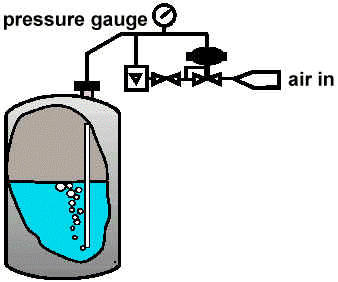This simple Bubbler level measurement has a dip tube installed with the open end close to the bottom of the process vessel.
A flow of gas, usually air or nitrogen passes through the tube and the resultant air pressure in the tube corresponds to the hydraulic head of the liquid in the vessel…
The air pressure in the bubbler tube varies proportionally with the change in head pressure.
Bubbler Level Sensor Theory

Advantages
Simplicity of design and low initial purchase cost are frequently given as advantages of bubblers, but this is somewhat misleading.
The system consists of a pipe, an air supply, a pressure transmitter and a differential pressure regulator. The regulator produces the constant gas flow required to prevent calibration changes.
Disadvantages
Calibration is directly affected by changes in product density. It is frequently also necessary to periodically clean this device.
The tip of the pipe can collect material from the process, solidify, and plug the hole.
Bubblers are not suitable for use in non-vented vessels.
Practical Notes
Instrument air lines should be trace heated if there is a frost risk. Calibration of a bubbler system should be at maximum temperature to avoid overfills.
Accuracy depends on a stable air supply and is limited by the regulator, which may be + 10% of full scale. In applications where the purge air is exposed to a hazardous substance, additional steps must be taken to contain any possible contamination.